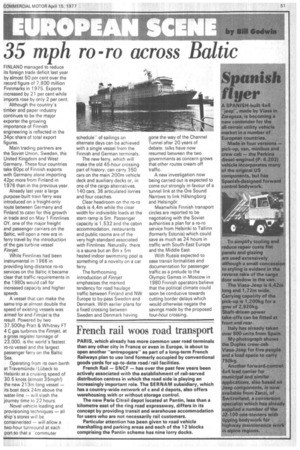35 mph ro-ro across Baltic
Page 53

If you've noticed an error in this article please click here to report it so we can fix it.
FINLAND managed to reduce its foreign trade deficit last year by almost 50 per cent over the record figure of 7,800 million Finnmarks in 1975. Exports increased by 21 per cent while imports rose by only 2 per cent.
Although the country's timber and paper industry continues to be the major exporter the growing importance of Finnish engineering is reflected in the 34pc'share of total export figures.
Main trading partners are the Soviet Union, Sweden, the United Kingdom and West Germany. These four countries take 60pc of Finnish exports with Germany alone importing 42pc more from Finland in 1 976 than in the previous year.
Already last year a large purpose-built train ferry was introduced on a freight-only route between Germany and Finland to cater for this growth in trade and on May 1 Finnlines OY, one of the major freight and passenger carriers on the Baltic, will open a new era in ferry travel by the introduction of the gas turbine vessel Finnjet.
While Finnlines had been instrumental in 1966 in providing long-distance ro-ro services on the Baltic it became clear that traffic requirements in the 1980s would call for increased capacity and higher speeds.
A vessel that can make the same trip at almost double the speed of existing vessels was aimed for and Tinnier is the result. Powered by two 37,500hp Pratt & Whitney FT 4 C gas turbines the Finnjet, at a gross register tonnage of 23,000, is the world's fastest ro-ro vessel and the largest passenger ferry on the Baltic Sea.
Operating from its own berth at Travemunde /Lubeck to Helsinki at a cruising speed of 30.5 knots (almost 35mph!) the new 213m-long vessel — its boat deck 24m above the water-line.— will slash the journey time to 22 hours.
Novel vehicle loading and provisioning techniques — all ship's stores will be containerised — will allow a two-hour turnround at each port so that a ''commuter
scheduleof sailings on alternate days can be achieved with a single vessel from the Finnish and German terminals.
The new ferry, which will make the old 45-hour crossing part of history, can carry 350 cars on the main 200m vehicle deck and auxiliary decks or, in one of the cargo alternatives, 140 cars, 36 articulated lorries and four coaches.
Clear headroom on the ro-ro deck is 4,4m while the clear width for indivisible loads at the stern ramp is 5m. Passenger capacity is 1,532 and the cabin accommodation, restaurants and public rooms are of the very high standard associated with Finnlines. Naturally, there is a sauna but an 8m x 5m heated indoor swimming pool is something of a novelty on a car ferry.
The forthcoming introduction of Finnfet emphasises the marked tendency for road haulage traffic between Finland and NW Europe to by-pass Sweden and Denmark. With earlier plans for a fixed crossing between Sweden and Denmark having gone the way of the Channel Tunnel after 20 years of debate, talks have now resumed between the two governments as concern grows that other routes cream off traffic.
A new investigation now being carried out is expected to come out strongly in favour of a tunnel link at the Ore Sound Narrows to link HAIsingborg and Helsingor.
Meanwhile Finnish transport circles are reported to be negotiating with the Soviet authorities a plan for a ro-ro service from Helsinki to Tallinn (formerly Estonia) which could save as much as 24 hours in traffic with South-East Europe and the Middle East.
With Russia expected to ease transit formalities and documentation for passenger traffic as a prelude to the Olympic Games in Moscow in • 1980 Finnish operators believe that the political climate could soon be conducive towards cutting border delays which would otherwise negate the savings made by the proposed four-hour crossing.




























































































